Family : Cytinaceae

Text © Prof. Pietro Pavone

English translation by Mario Beltramini

Cytinus ruber is a Mediterranean plant unable to carry out chlorophyll photosynthesis due to lack of green leaves. Therefore it lives as a parasite on the plants of pink flower Cistus, like this Cistus albidus © Giuseppe Mazza
Cytinus ruber (Fourr.) Fritsch is a parasitic plant, lacking the ability to photosynthesize (holoparasite), belonging to the family Cytinaceae A.Rich. of the order Malvales.
In the past the family was included in the order Rafflesiales but molecular studies have indicated its nesting inside the order Malvales (APG III, 2009).
The genus Cytinus includes eight species with a disjoint distribution across two centres of diversity, one in the Mediterranean area (Cytinus hypocistis; Cytinus ruber) and the other in southern Africa (Cytinus capensis; Cytinus sanguineus; Cytinus visseri) and Madagascar (Cytinus baronii; Cytinus glandulosus; Cytinus malagasicus).
No fossils of Cytinus, have been found, however estimates based on molecular data (single-copy nuclear genes) place its origin on 72,1 million years ago.
Cytinus ruber is found from Portugal to Turkey, Bulgaria, Cyprus, Israel, Georgia, north-western Africa (Canary Islands, Morocco, Algeria, Tunisia), in the environments where are present plants of Cistus with pink flowers, such as Cistus creticus L. and Cistus albidus L., with flowering going from March to June and fruiting between August and November.
These two species, typical to the Mediterranean thicket, are small evergreen bushes belonging to the family
Cistaceae with opposite leaves, of grey-green colour and woody stem just one metre tall.
They display stellate and glandular hairs especially on the leaves, on the sepals and on the young stems. The radial symmetric flowers, have thin and crumpled petals, of delicate pink or purple colour and open in the morning and wither in the evening.
The name of the genus Cytinus comes from the ancient Greek “κῠτῐνος” (cytinos), cytinus, from “kytos”, hollow vessel, name of the calyx of the flower of the pomegranate tree (Theophrastus and Hippocrates) resembling the flowers of this plant. The specific epithet ruber comes from “rúbeo”, reddish, to be red.
The Italian common name is Ipocisto rosso; Roter Cistrosenwürger in German and Red Rockrose-Parasite, in English; Cytinet rouge, in French.
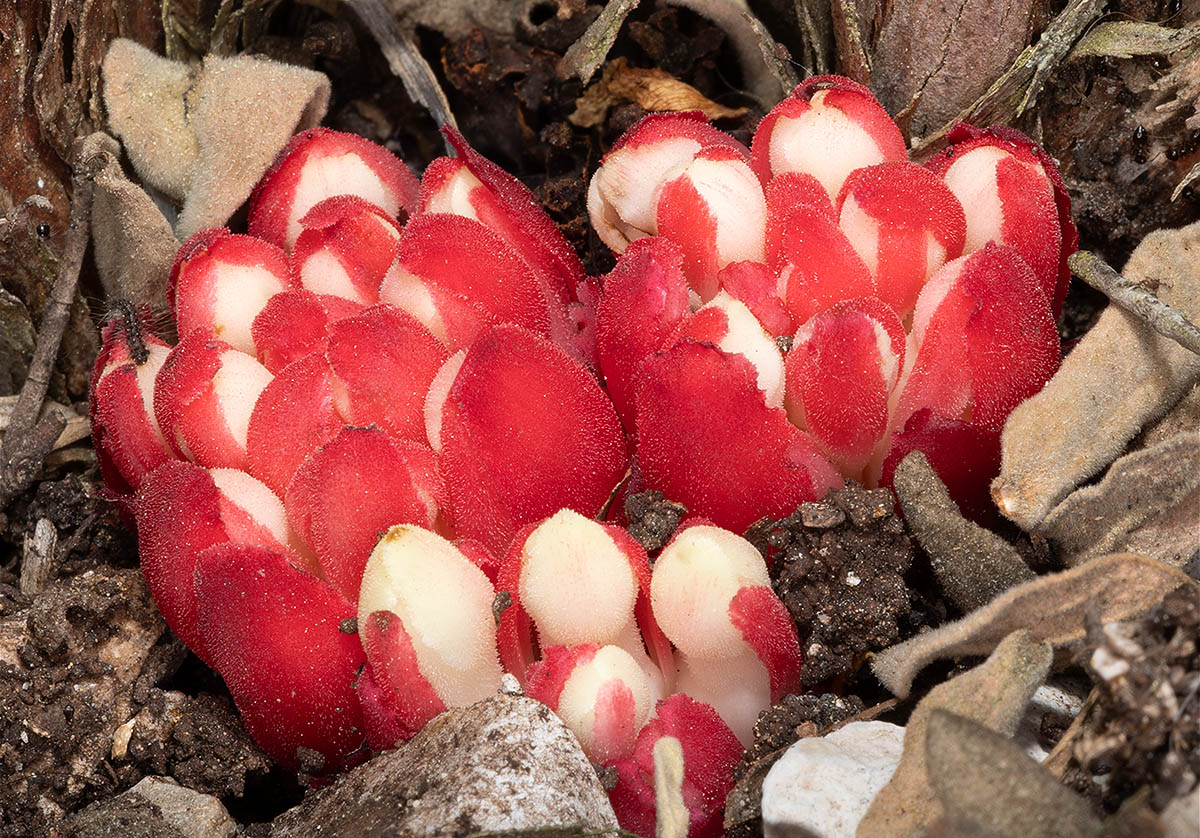
It’s only visible from March to May, when sprouts on the ground for blooming from the root tissues of the host © Giuseppe Mazza
It was Karl Fritsch (1864-1934) to validly publish the name of this species in Exkursionsflora für Österreich und die ehemals österreichischen Nachbargebiete (Excursionsfl. Oesterreich, ed. 3: 69, 1922).
Cytinus ruber is a perennial monoecious plant, characterized by a marked morphological reduction.
As a matter of fact, the vegetative body is very small, incapable of photosynthesis, and grows only inside its host (endophyte). It can be seen only during flowering, no more than ten centimetres high, that annually, from March to May, stands on the ground from the host’s root tissues.
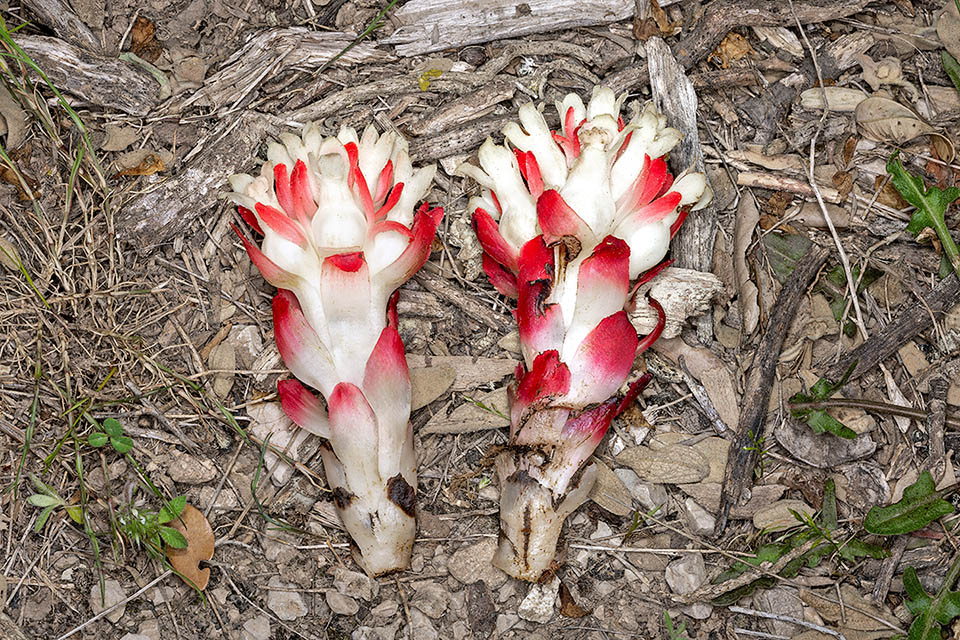
The buried trunk, no taller than about ten centimeters, is covered by fleshy raspberry red scales and produces flowers merged in inflorescences © Giuseppe Mazza
The stem, covered by fleshy scales and of raspberry red colour produces flowers grouped in inflorescences.
Several inflorescences may form from the same root of the host, but they can belong to the same individual or to genetically different ones.
The inflorescence is a dense globose spike with a number of flowers that may vary from 3 to 20, divided into male and female.
The flowers have a perianth gradually narrowing under the lobes. The corolla, in the male flowers as well as in the female, is composed of 4 petals, white or pinkish yellow, that when ripe get bulbous and toothed.
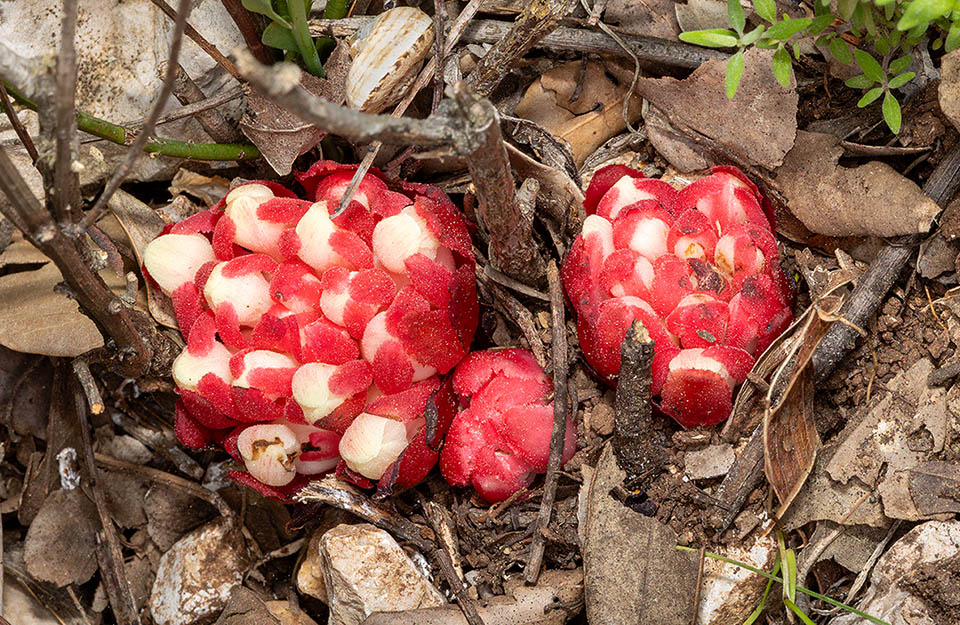
Here others emerge at different growth stages. They are edible with medicinal virtues © Giuseppe Mazza
The about 10-20 mm male flowers are situated inside the inflorescence and have funnel-shaped perigonium, the female ones, placed outside, are slightly bigger, flask shaped at the ovary.
Both female and male flowers produce similar quantities of nectar, which accumulates in the nectariferous cavity, but the sugar concentration is bigger in the female flowers.
Inside the inflorescence a single flower lasts about 6 days. The female flowers open a few days before the male. The pollinators are mainly ants and flying insects (bees, coleopterans) who, while looking for nectar, come into contact with the reproductive organs.
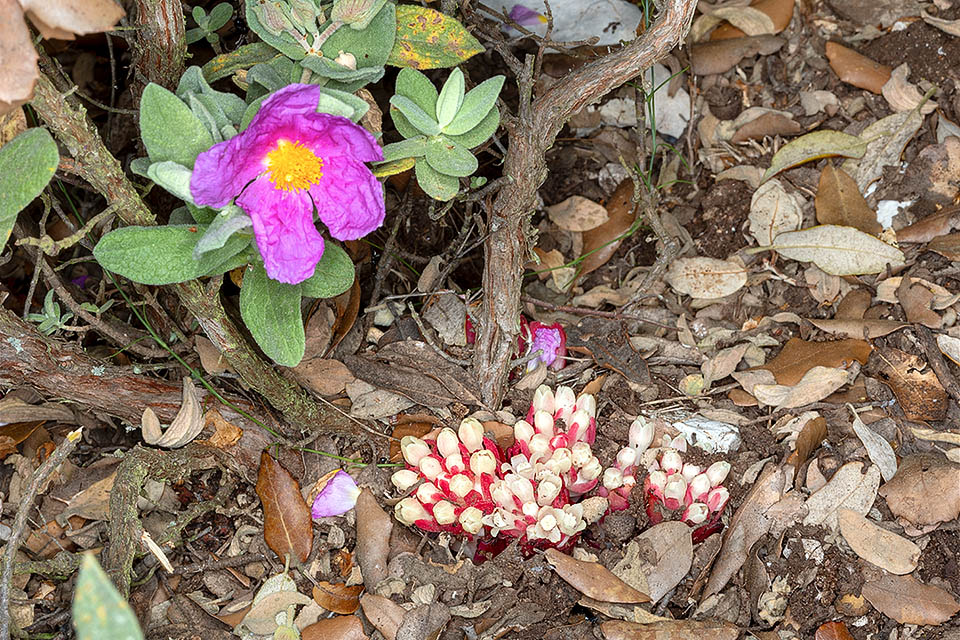
Hard to say to what extent Cistus suffers. Surely it will have to work more, because the parasite steals the elaborate of the plant, but it doesn’t lack leaves to make them © Giuseppe Mazza
Particularly, the ants constantly touch the anthers with their bodies and carry the pollen to deposit it on the vast stigmatic surface of the female flowers.
The fruit, of 7 mm of diameter, is a white fleshy berry containing pulverulent seeds, about 25.000 per fruit, immersed in a viscous pulp. The high number is justified because only very few seeds can reach the host to be parasitized.
A study on Cytinus ruber and on the cognate Cytinus hypocistis (Annals of Botany 100: 1209–1217, 2007) has emphasized the presence of similar endophytic systems, regardless of the host being parasitized. These are cellular filaments that extend tangentially through the pericycle and the phloem of the root of the host in order to subtract elaborates to the host plant to the advantage of the growth of the parasite.
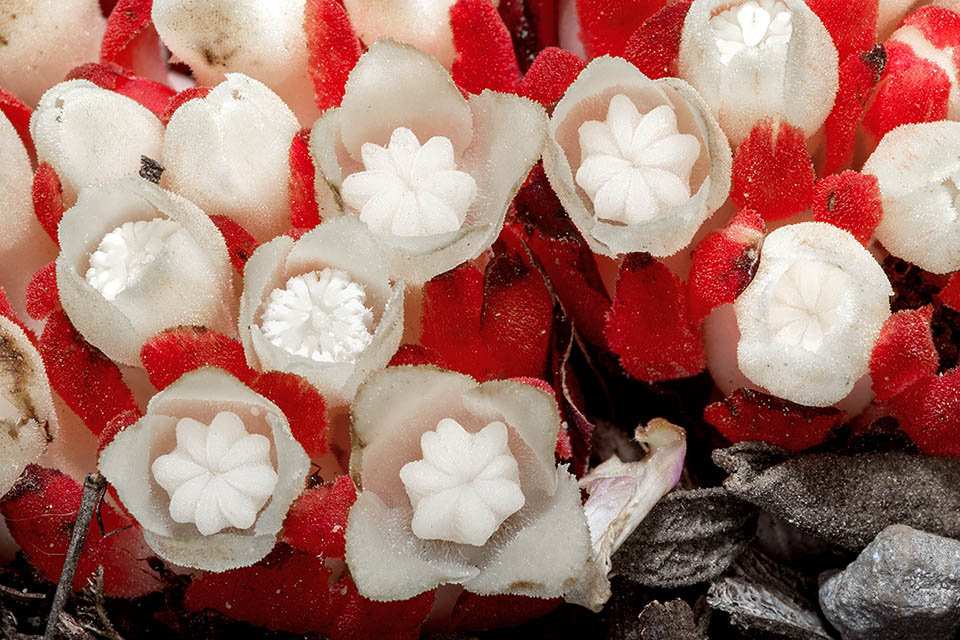
Close-up of two inflorescences. The female flowers open few days before the male ones staying in the center © Giuseppe Mazza
At the same time the filaments grow radially so as to pass through the cambial area of the host and colonize the xylematic zone where the transportation of the water and of the mineral salts occurs. Therefore, the endophytic sistem of both species of Cytinus is present in all root tissues of the host reaching the maximum complexity in the xylem of the host.
As have not been observed direct contacts xylem-xylem or phloem-phloem it is probable that the transfer of the nutrients may happen through the cellular walls (apoplastic way), that is without crossing any membrane, between the cells of the parasite and those of the host.
This explains because a direct contact with the xylem should have caused the formation of a defense on the part of the host with the closure of the vessels, by means of eversions (tillas), preventing any transfer.
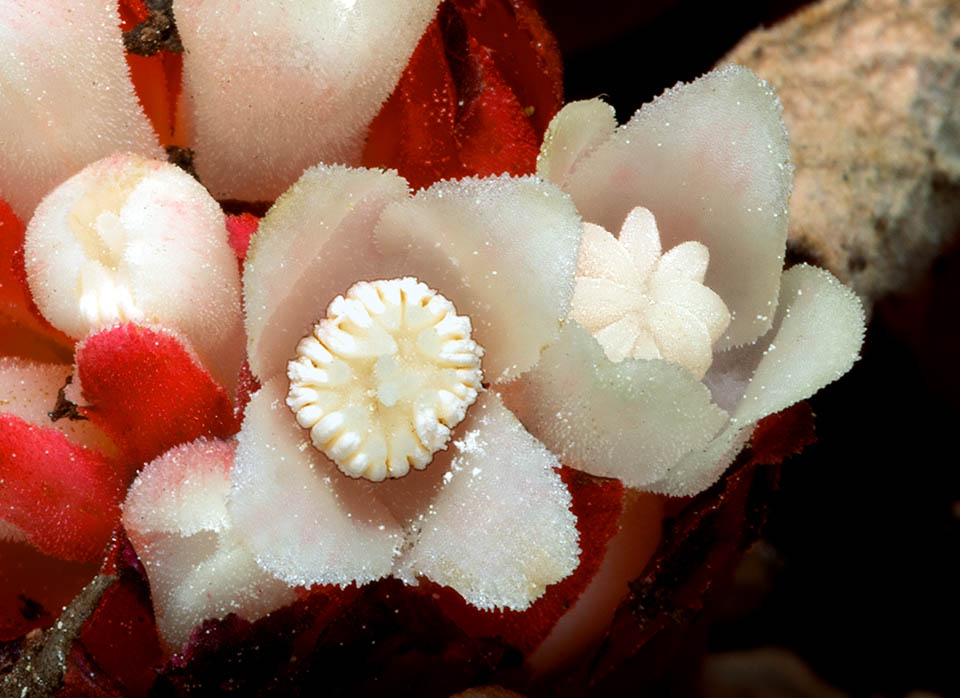
Here compared, the male being on the left. Both produce similar quantities of nectar but the sugars concentration is bigger in the female ones © Giuseppe Mazza
Moreover, it is possible that the cells of the endophyte of Cytinus, placed between the cells of the phloem of the host, catch from them the photoassimilates and can carry them through their own cytoplasm, taking advantage of the continuity system of the plasmodesmata (symplastic way). The endophyte of Cytinus, thanks to this flow of water and nutrients, is capable to grow, bloom and bear fruits.
Cytinus ruber is considered edible and the inflorescence is cooked as an asparagi substitute. The pulp of the ovary is sweet. This practice was current in the Adriatic islands of Croatia.
In traditional medicine of various European zones, the extracts of the inflorescences, due to their haemostatic and astringent properties were used in cases of dysentery, To soothe the inflammations of the throat and of the eyes. Also in the central-southern part of Sardinia, ethnobotanical investigations have confirmed that extracts of Cytinus were used as astringent, haemostatic and tonic substances.
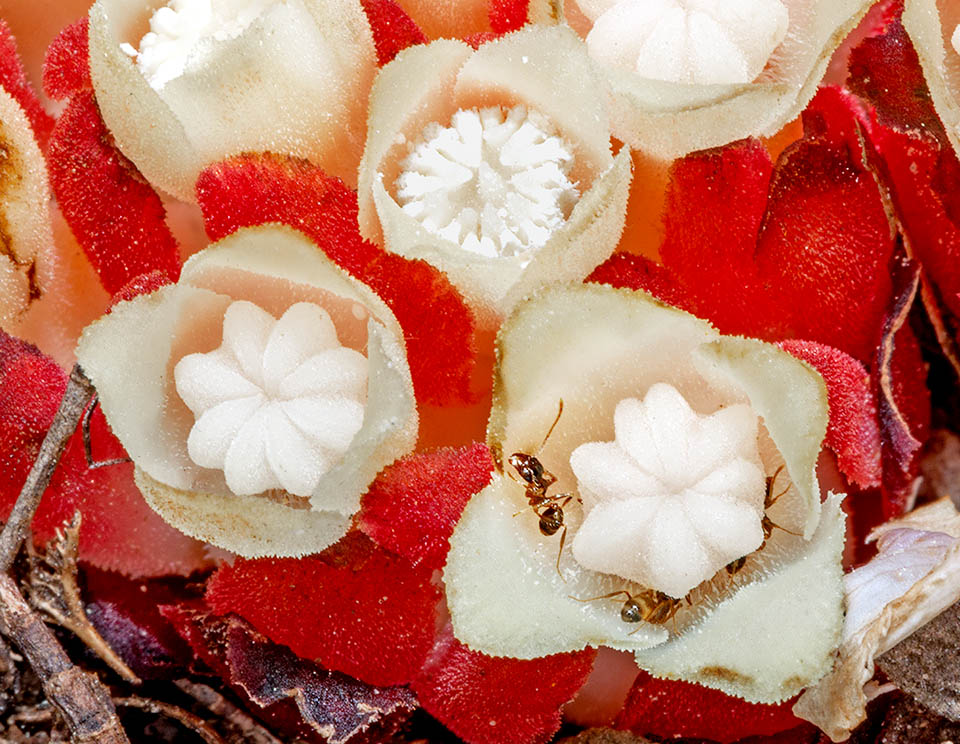
Pollination is mainly entrusted to the ants, but also to the passing-by flying insects such as bees and coleopterans © Giuseppe Mazza
In a recent study (Plants 2021, 10, 146) on the chemical and nutritional composition of Cytinus ruber, on plants coming from Greece, have been found hydrolyzable tannins (or gallotannins).
The presence of tannins, on ethanolic and aqueous extracts, has been also found in plants collected in Sardinia.
The tannins, besides having antioxidant properties, also have an antimicrobial activity. This last activity has been tested on three species of Gram-positive bacteria (Staphylococcus aureus, Staphylococcus epidermidis, Enterococcus faecium) that have resulted sensitive with a minimum inhibitory concentration (MIC, µg/ml) between 125 and 500 μg/ml, for the aqueous extracts, and between 31,2V5 and 250 μg/ml. for the ethanolic extracts.
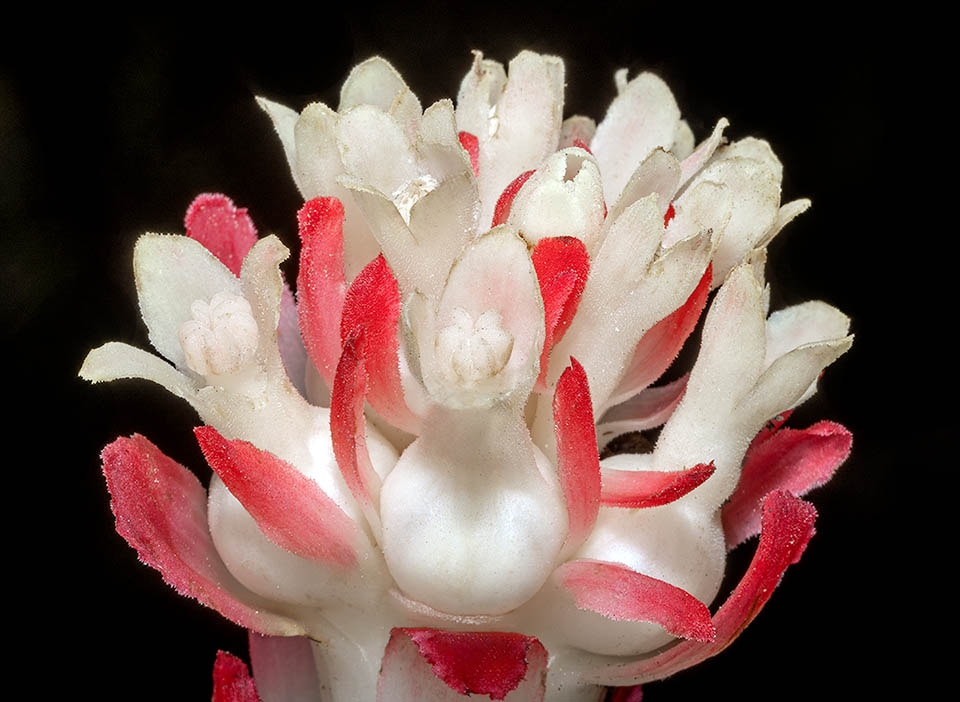
The flowers last about 6 days and the base of fecundate female ones gets bigger transforming in a fleshy white berry containing even 25.000 seeds © Giuseppe Mazza
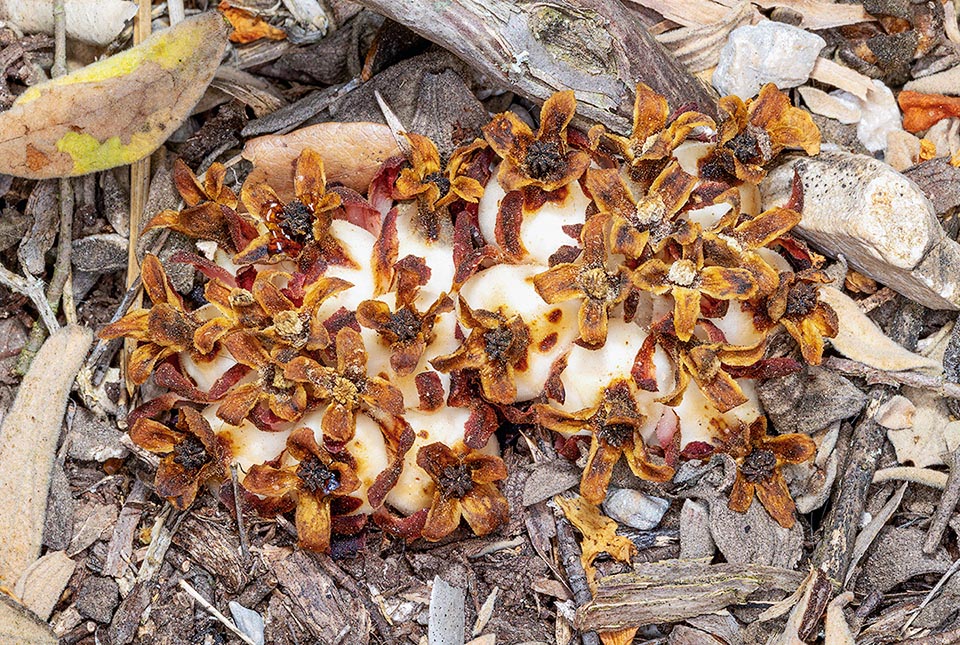
They are powdery, immersed in a viscous pulp. Mainly dispersed by ants, they germinate often in the anthills close to the roots of other Cystus © Giuseppe Mazza
On the Gram-negative strains (Pseudomonas aeruginosa and Klebsiella pneumoniae) has not been found any antimicrobial activity.
These studies indicate that Cytinus could be a natural source of antimicrobial and antioxidant substances.
The Red Rockrose-Parasite has two subspecies: Cytinus ruber subsp. ruber, present in the Mediterranean area, and Cytinus ruber subsp. canariensis (Webb & Berthel.) Finschow ex G.Kunkel, of the Canary Islands.
Synonyms: Cytinus clusii (Nyman) Gand.; Cytinus hypocistis subsp. clusii Nyman; Cytinus hypocistis var. kermesinus Guss.; Cytinus hypocistis subsp. kermesinus (Guss.) Arcang.; Hypocistis hypocistis var. kermesinus (Guss.) Linding.; Hypocistis kermesina (Guss.) Kuntze; Hypocistis rubra Fourr.
